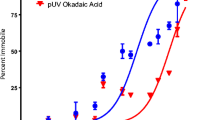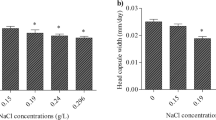Abstract
Backgrounds
Tributyl tetradecyl phosphonium chloride (TTPC) is a biocide used in hydraulic fracturing fluid to minimize bacterial contamination.
Methods
This study used the larvae of the freshwater insect Chironomus riparius to investigate the toxicity of TTPC, NaCl, and TTPC+NaCl.
Results
LC50s (mg/L) at 24 hours for TTPC, NaCl, and TTPC+NaCl were 0.57, >10,000, and 0.32, respectively, indicating a synergistic effect for TTPC+NaCl. ATP production was significantly increased in response to TTPC alone as compared to controls, but decreased significantly when TTPC was combined with NaCl, indicating severe damage to mitochondria. Superoxide dismutase (SOD) activity and lipid hydroperoxides (LPO) levels both increased in response to TTPC treatment, however, only LPO activity increased when TTPC was combined with NaCl. Red laser stimulation failed to enhance ATP production in response to increasing concentrations of TTPC and TTPC+NaCl.
Conclusion
Taken together, these results indicate that hydraulic fracturing fluids entering freshwater ecosystems may put macroinvertebrates at risk.
Similar content being viewed by others
References
Burton, G. A. et al. Hydraulic “Fracking”: Are surface water impacts an ecological concern? ET&C 33, 1679–1689. doi:10.1002/etc.2619 (2014).
Ferrer, I. & Thurman, E. M. Chemical constituents and analytical approaches for hydraulic fracturing waters. TrEAC 5, 18–25. doi:10.1016/j.teac.2015.01.003 (2015).
Gordalla, B. C., Ewers, U. & Frimmel, F. H. Hydraulic fracturing: A toxicological threat for groundwater and drinking-water? Environmental Earth Sciences 70, 3875–3893. doi:10.1007/s12665-013-2672-9 (2013).
Briskin, J. S. & Yohannes, L. Overview of U.S. EPA’s Study of the Potential Impacts of Hydraulic Fracturing for Oil and Gas on Drinking Water Resources. EPA, 197–203. doi:10.1021/bk-2015-1216.ch009 (2015).
Davies, J. Risk evaluation determining whether environmental emergency planning is required under the tributyl tetradecyl phosphonium chloride (CAS #: 81741-28-8). Japca 38, 1111–1113. doi:10.1080/08940630.1988.10466452 (1988).
Kahrilas, G. A., Blotevogel, J., Stewart, P. S. & Borch, T. Biocides in hydraulic fracturing fluids: A critical review of their usage, mobility, degradation, and toxicity. Environ Sci Technol 49, 16–32. doi:10.1021/es503724k (2015).
Material Safety Data Sheet: Bellacide 350 (TTPC), https://doi.org/www.wateradditives.com/files/products/tech_bulletins/Bellacide%20350_Technical%20Bulletin_RO%20Membrane%20Compatibility_Oil%20and%20Gas_8.5x11.pdf (2009).
Stringfellow, W. T., Domen, J. K., Camarillo, M. K., Sandelin, W. L. & Borglin, S. Physical, chemical, and biological characteristics of compounds used in hydraulic fracturing. J Hazard Mater 275, 37–54. doi:10.1016/j.jhazmat.2014.04.040 (2014).
Kim, T. & Park, H. Tributyl tetradecyl phosphonium chloride for biofouling control in reverse osmosis processes. Desalination 372, 39–46. doi:10.1016/j.desal.2015.06.019 (2015).
Xue, Y., Xiao, H. & Zhang, Y. Antimicrobial polymeric materials with quaternary ammonium and phosphonium salts. IJMS 16, 3626–3655. doi:10.3390/ijms16023626 (2015).
Yoshimatsu, T. & Hiyama, K. Mechanism of the action of didecyldimethylammonium chloride (DDAC) against Escherichia coli and morphological changes of the cells. Biocontrol Sci 12, 93–99. doi:10.4265/bio.12.93 (2007).
Pastor, M. M., Proft, M. & Pascual-Ahuir, A. Mitochondrial Function Is an Inducible Determinant of Osmotic Stress Adaptation in Yeast. JPC. doi: 10.1074/jbc.M109.050682 (2009).
Kwon, J., Kim, H., Kim, P. & Choi, K. Didecyldimethylammonium chloride induces oxidative stress and inhibits cell growth in lung epithelial cells. Mol Cell Toxicol 10, 41–45. doi:10.1007/s13273-014-0005-z (2014).
Haluszczak, L. O., Rose, A. W. & Kump, L. R. Geochemical evaluation of flowback brine from Marcellus gas wells in Pennsylvania, USA. Applied Geochemistry 28, 55–61. doi:10.1016/j.apgeochem.2012.10.002 (2013).
Water and Wastes Digest. Pennsylvania DEP investigates elevated TDS in Monongahela River. https://doi.org/www.wwdmag.com/Pennsylvania-DEP-investigates-elevated-TDS-in-Monongahela-River (2008).
Chen, L. et al. Changes in metabolites, antioxidant system, and gene expression in Microcystis aeruginosa under sodium chloride stress. Ecotoxicol Environ Saf 122, 126–135. doi:10.1016/j.ecoenv.2015.07.011 (2015).
Michailova, P. V. Rearrangements in chironomidae (Diptera) genomes induced by various environmental stress factors. Russian Journal of Genetics: Applied Research 1, 10–20. doi:10.1134/s2079059711010035 (2011).
Nowak, C. Consequences of Environmental Pollution on Genetic Diversity in Populations of The Midge Chironomus riparius, Cuvillier Verlag Gottingen, Germany (2008).
Bianchini, L. F. et al. Metabolism and antioxidant defense in the larval chironomid Tanytarsus minutipalpus: adjustments to diel variations in the extreme conditions of Lake Magadi. BiO 6, 83–91. doi:10.1242/bio.021139 (2017).
Siegel L. Hazard Identification for Human and Ecological Effects of Sodium Chloride Road Salt, TRB (2007).
Didecyl Dimethyl Ammonium Chloride (DDAC) Safety Data Sheet. https://doi.org/www.kellysolutions.com/erenewals/documentsubmit/KellyData%5COK%5CPesticide%5CMSDS%5C88391%5C10324-209-88391%5CAntimicrobial_220_5_23_2016_5_27_05_PM.pdf (2016).
Avci, P. et al. Low-level laser (light) therapy (LLLT) in skin: stimulating, healing, restoring. Semin Cutan Med Surg, doi:10.1088/978-1-6270-5455-3ch8 (2013).
Jastroch, M., Divakaruni, A. S., Mookerjee, S., Treberg, J. R. & Brand, M. D. Mitochondrial proton and electron leaks. Essays Biochem 47, 53–67. doi:10.1042/bse0470053 (2010).
Syromyatnikov, M. Y., Kokina, A. V., Lopatin, A. V., Starkov, A. A. & Popov, V. N. Evaluation of the toxicity of fungicides to flight muscle mitochondria of bumblebee (Bombus terrestris L.). PBP 135, 41–46. doi:10.1016/j.pestbp.2016.06.007 (2017).
Wiseman, S., Anderson, J., Liber, K. & Giesy, J. Endocrine disruption and oxidative stress in larvae of Chironomus dilutus following short-term exposure to fresh or aged oil sands process-affected water. Aquat Toxicol 142-143, 414–421. doi:10.1016/j.aquatox.2013.09.003 (2013).
Michea, L., Combs, C., Andrews, P., Dmitrieva, N. & Burg, M. Mitochondrial dysfunction is an early event in high-NaCl-induced apoptosis of mIMCD3 cells. AJPRenal 282. doi:10.1152/ajprenal.00301.200 (2002).
Zheng, X., Long, W., Guo, Y. & Ma, E. Effects of cadmium exposure on lipid peroxidation and the antioxidant system in fourth-instar larvae of Propsilocerus akamusi (Diptera: Chironomidae) under laboratory conditions. J Econ Entomol 104, 827–832. doi:10.1603/ec10109 (2011).
Author information
Authors and Affiliations
Corresponding author
Rights and permissions
About this article
Cite this article
Alali, Z.H., Bentivegna, C.S. Hydraulic fracturing fluid biocide, tributyl tetradecyl phosphonium chloride, causes mitochondrial dysfunction that is enhanced by sodium chloride in Chironomus riparius. Mol. Cell. Toxicol. 15, 31–39 (2019). https://doi.org/10.1007/s13273-019-0004-1
Received:
Accepted:
Published:
Issue Date:
DOI: https://doi.org/10.1007/s13273-019-0004-1




